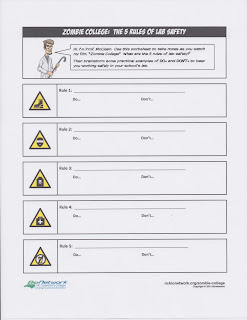Benchmark: SC.7.N.1.1
Essential Question: What makes a science lab safe?
Learning Objectives:
Students will be able to:
-Determine the five basic rules of lab safety.
-Identify do’s and don’t that make a laboratory activity safe or unsafe.
BELL RINGER- Following Directions Handout 5 minutes
SUPPLIES/TECHNOLOGY: white board and markers, computer(s) with internet access, LCD projector
VOCABULARY: fire blanket, eye wash station, first aid kit, evacuation map, fire extinguisher, fume hood, safety shower
HOME LEARNING: HL 1 Analyzing Elements of the Scientific Method-Use the supplied vocabulary to answer A-F on your own paper.
AGENDA
WHOLE GROUP
-Bell Ringer - Following directions handout 5 min
-I do - introduction of self/motivational talk 5 min
-I do - review: vision statement, schedule, syllabus, rules, expectations, fire/code red/code yellow drills. 20 min
-I do - distribute and explain HL 1 Analyzing elements of the scientific method and the vocabulary sheet 2 min
-we do - set up notebooks so that we can begin placing pages in the notebook. 20 min
-we do - Zombie College The 5 rules of lab safety video /handout10 min
-we do - review lab safety contract
SMALL GROUP/INDEPENDENT PRACTICE/DI
-you do - visit website to find the SWAY on Lab Safety and complete the game portion. 10 min
-you do - exit ticket - write to explain the importance of one of the 5 rules of lab safety. 5 min
Today, we will explore Lab Safety. Use your phone to log into your Office 365 site. Visit the sway listing for you.
If you cannot find the link, click on the one listed below:
Laboratory Safety
If you did not get a syllabus, see me. Also, be sure to get a copy of the receipt of syllabus, which must be signed by both you and your parent/guardian.
Additionally, see me to pick up a copy of the lab safety contract.
Below, find a copy of the home learning, the vocabulary supplement, and the Zombie College Lab Safety handout. All of these will be placed in your interactive notebook.
If you did not get a syllabus, see me. Also, be sure to get a copy of the receipt of syllabus, which must be signed by both you and your parent/guardian.
Additionally, see me to pick up a copy of the lab safety contract.
Below, find a copy of the home learning, the vocabulary supplement, and the Zombie College Lab Safety handout. All of these will be placed in your interactive notebook.


















































